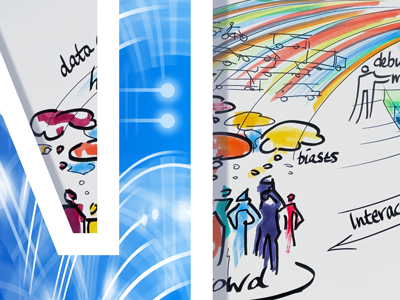Overview
Good data is central to effective AI applications. This course teaches the basics of data for AI, covering what data is needed, how to extract data from existing databases and basic data skills including setup of a Python notebook environment, basic data exploration and simple data visualizations.
Artificial Intelligence and Machine Learning have become central techniques for most services and products, ranging from web-based systems to medical procedures, self-driving cars – even intelligent coffee makers.
Alongside algorithms, data is central to AI applications. Without solid data management, AI projects typically underperform or even fail. Unfortunately, the relevance and complexity of handling data is frequently underestimated.
That’s why we developed this course which covers foundational questions like “Why is data important to AI?” and “What data does AI need?” and covers more application-oriented topics and skills like how to extract, load and query data using an SQL pipeline.
In the second part of the course, you will learn basic data engineering skills, including how to setup your Python notebook environment, explore data with advanced pandas functions, and create simple and clear data visualizations.
This introductory course is targeted at learners with little experience in data management or Python-based data management who want to develop Python-based AI applications in the future. The course covers a brief introduction into data management for AI, relational data management (e.g., SQL), and practical data handling skills in Python, pandas, and Jupyter. This allows you to build a foundation to prepare for future AI and Machine Learning development with Python.
What You'll Learn:
- Why Data Management is central to AI applications
- What kind of data these applications need
- How to obtain data for AI applications
- How to extract and query data from existing databases using SQL
- How to setup your Python notebooks
- How to use the pandas library to work with tabular data
- How to visualize data using the Seaborn library
Quote from Learner
"Processing large data files is necessary everyday, so this was a good starter course on pandas hacks. It was easy to follow and useful, with plenty of hands on experience. I improved my pandas skills and got GS credits." - Shubhalaxmi Mukherjee, PhD students from The Netherlands
Details
Course Syllabus
Week 1:
- We ask why we should care about data management for Artificial Intelligence and Machine Learning (ML) systems.
- We examine which data are needed in the ML lifecycle and what properties that data should have.
- We discuss the effort and time needed for data management activities, and look at possible data sources.
Week 2:
- The basic key concepts of data management, such as databases, data models and data schemas are all introduced.
- The Relational Data Model is explained and contrasted with the Single-Table Model (like CSV and Excel) and Document Models.
Week 3:
- We show how to extract data from existing relational databases using SQL queries and converting the query results into CSV files for further processing using pandas in Python notebooks.
Week 4:
- The different ways setoff setting up and running Python notebooks are covered, including cloud-based notebooks and local notebooks.
- We will take you step by step through the process of setting up your conda environment and installing Jupyter and pandas libraries.
- You will learn how to run notebooks in VS code.
Week 5:
- Become a pandas expert.
- Explore the essential functionalities of pandas and, most importantly, write elegant and efficient Python pandas code to process and engineer tabular data.
Week 6:
- You will learn how to make simple and clear scientific figures in Python using the Seaborn library.
- Use the core functions provided by Seaborn to make beautiful statistical plots.
Qualifications
Chartered Engineering Competences
All our online courses and programs have been matched to the competences determined by KIVI’s Competence Structure, a common frame of reference for everyone, across all disciplines, levels and roles.
These competences apply to this course:
- A1: Extend your theoretical knowledge of new and advancing technologies.
Admission
This is a Massive Open Online Course (MOOC) that runs on edX.
Prerequisites
- Basic Python programming skills
- A computer running Windows, MacOS, Linux is needed. Chromebooks and mobile operating systems are not supported.


